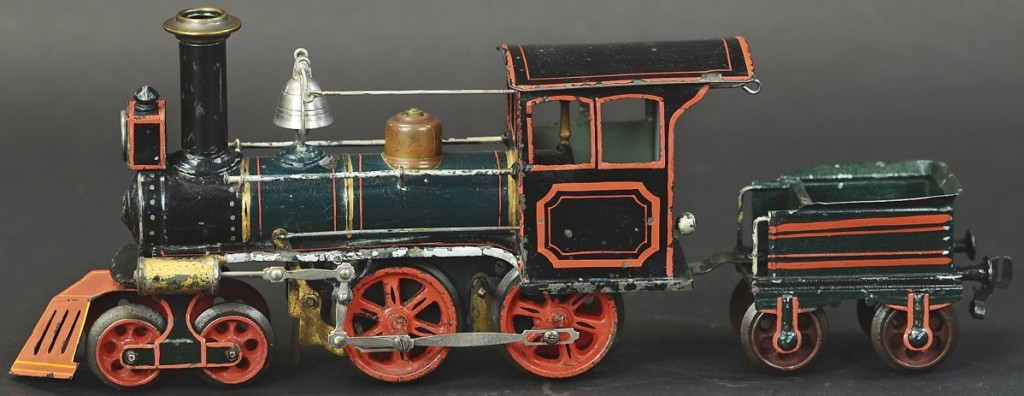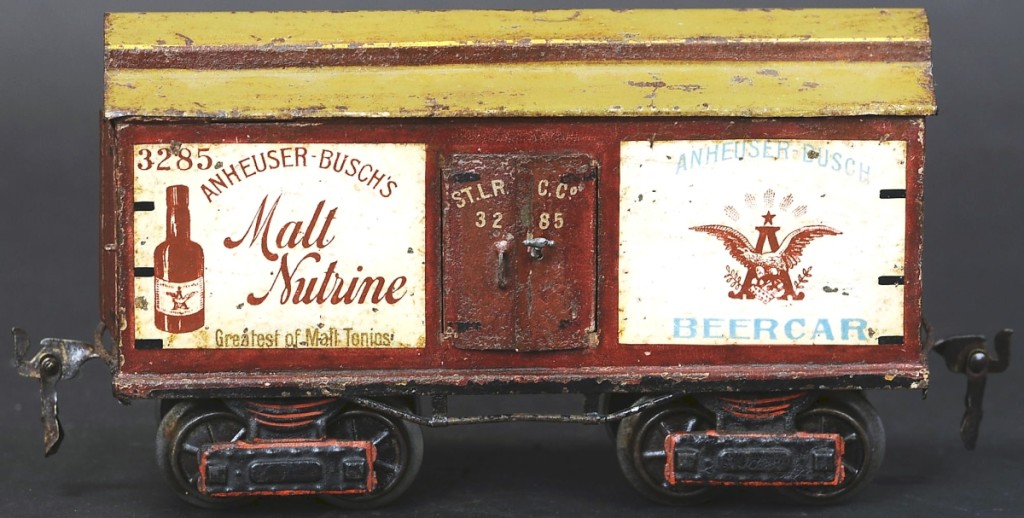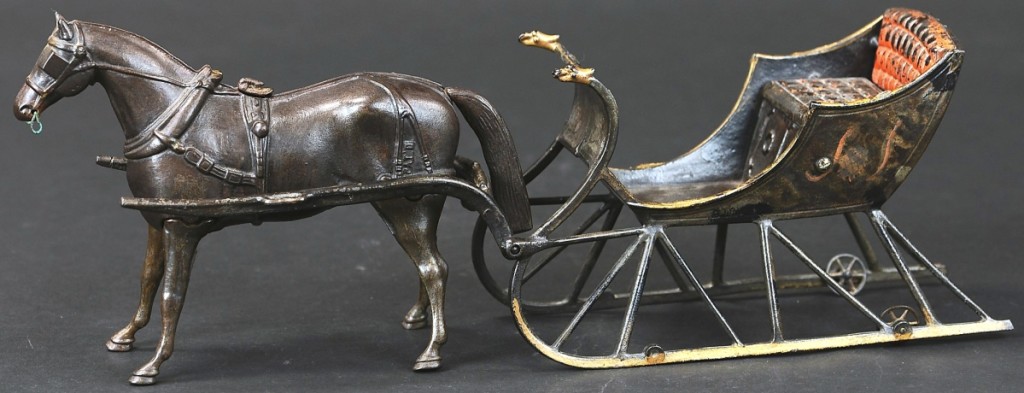
The auction’s top highlight came in at $90,000 above a $15,000 high estimate for the Marklin outline 4-4-0 locomotive, the first model loco the company made for the American market from 1895 to 1903. To appeal to the westward-bound Americans, Marklin added the cowcatcher and bell to their standard fare.
Review by Greg Smith, Photos Courtesy Bertoia Auctions.
VINELAND, N.J. – In June of this year, Bertoia Auctions unveiled the premier sale from one of West Virginia’s greatest toy collectors, Paul Cole. The 862-lot auction grossed more than $2.5 million.
The firm was back on the grind October 15-16 with the second offering from the collector, which unleashed another 836 lots into the market and grossed nearly $1.9 million. On the first day, Cole’s collection of toys included European windups, automobiles, penny toys, horse-drawn and other cast iron pieces, American tin and clockwork toys, bell toys, still banks and light pressed steel entries. The second day, where many of the highest-grossing lots were found, was dedicated to trains.
Cole was a collector for 50 years before he passed away in 2020. His early interest began in Lionel trains in the 1970s before expanding to European makers in the 1990s. He made quick work with the latter category, the auction house writing that Cole’s collection “is arguably one of the finest European train collections in this country.”
Leading the auction at $90,000 was the first model locomotive that German manufacturer Marklin made for the American market. The outline 4-4-0 loco was in gauge 1 with hand painted details. Marklin produced and exported this model, seen in its catalog as No. 1031, between 1895 and 1903. Their attempt at meeting the demanding taste of Americans translated to adding cowcatchers and bells to their normal fare. It would not be until the 1930s when the company produced distinctly American trains for that market.
Collectors were again frothing with interest for the rare beer cars Cole had collected. The June sale was topped by a $40,800 Schlitz beer car by Marklin for the American market, and a comparable result was found at $50,400 for a Malt Nutrine beer car this sale. Marklin produced the gauge 1 car for the American market and it stands as one of only three examples known. Anheuser-Busch’s Malt Nutrine debuted in 1895 and was marketed to women, its ads depicting nursing mothers who gained a restful sleep after taking a swill of the two percent alcohol drink. The company ran contests where they would send gold to doctors who could come up with the best copy for their art promotions. Other beer cars by Marklin included a Pabst Blue Ribbon gauge 1 model, $13,200, and a Budweiser car in gauge 1, $7,800.

Anheuser-Busch’s Malt Nutrine was a prohibition-era two percent alcohol beer advertised as nonalcoholic to mothers who needed a restful sleep. It was also advertised to doctors, a practice that would now bring class action lawsuits and bankruptcy. Marklin’s beer cars are coveted for their crossover appeal between breweriana and model train collecting. The Malt Nutrine car was the second highest lot in the sale when it sold for $50,400.
Furniture wagons accompanied by flat cars were desirable. For $48,000, one bidder walked away with a Gimbel Brothers furniture wagon with graphic paint and rare, possibly unique, lettering. While that was made for the American market to accompany the fervor for the popular American department store, the European market had Deutsche Möbel Transport Gesellshaft furniture wagon with flat car that sold for $21,600.
Cole’s stash of armored train cars and locos by Marklin came out in three lots, led by the K1021/0 loco at $28,800. In similar colors was an armored train car at $10,200 and another car together with a cannon car that brought $6,000. Marklin offered these trains from 1900 to as far back as 1909, according to some researchers. They were modeled after the armored train cars used by Britain in The Second Boer War in South Africa, a colonial pursuit fueled by the discovery of diamonds and gold in the Boer states. Related was a windup litho armored floor train in orange and black by Issmayer/Karl Bub that included a loco and two cars and sold for $6,600.
Marklin’s other American-market trains dotted the leader board. Two American Eagle cars were gauge 1 and differed only in color, the blue example reaching $27,600 and the orange example selling for $24,000. Both were near mint. At $20,400 was an observation car, gauge 1, that featured the same paint scheme as the Royal Blue Limited set, but without the writing. Three Congressional Limited cars in an attractive yellow paint with red and blue details sold for $19,200.
The collection was not wanting for pristine condition accessories – those buildings, stations, canopies, bridges and more that transform the long, parallel lines into veritable landscapes. Top was held by a Marklin platform extension accessory in gauge 1 with an adjustable track, circa 1906, that sold for $19,200. The accessory features a track with a little ticket shack on it, an overhead banner reading “Fahrkarten bereit halten,” or “Have Tickets Ready.” For the French market, Marklin produced the Gare-Central 2661 Station, a more elaborate example with a fine station and canopy that sold for $18,000. For the UK market, Marklin produced a nice country station that would endear those in the rural parts of the country. For $13,200, it was circa 1915 and featured simulation brickwork with colorful advertising and attractive awning.
Switching tracks to the toys that made up the sale’s first day, we find a smorgasbord of works by Ives, Kyser & Rex, Hubley, Pratt & Letchworth and other makers.

Top among the toys was Ives’ oversized cast iron cutter sleigh with articulated horse and fine paint. The delicate cast iron work is seen in the casting of the horse and the thin rods supporting the sleigh, as well as the eagle head posts off its front. It sold for $25,200.
Ives was represented by quality, the firm’s oversize cast iron cutter sleigh with articulated horse taking the lead at $25,200. Bertoia wrote that the toy, one of only a handful known, “is truly a masterpiece in cast iron detail.” The sleigh measures 18 inches long and was all original save for two replaced screws. Among the Ives clockwork toys was the Monkey Wood Chopper, $7,200; Uncle Tom The Fiddler, $5,700; and Washer Woman-Old Aunt Chloe, $5,400.
Even apart from the cutter sleigh, bidders were still willing to go high on Cole’s cast iron toy collection. At $19,200 was the Deluxe Burning Building by Carpenter, distinguished by its two-ladder set up. The company produced other two-story models with just one ladder, as well as a three-story building with a single ladder.
With Christmas around the corner, bidders were keen on a Kyser & Rex Santa Sleigh that Bertoia called a top example of the form. The original Santa figure keeps warm with a blanket around him, toys seen strewn across it. It sold for $9,600.
Over 60 bell toys found their apex in a Gong Bell Clown & Poodle, which went out for $8,400. The toy measured 12½ inches long and was in mostly original condition. For $6,000, one bidder walked home with the Drummer Boy, patented by Charles Bailey and produced by the W.H. Chapman Company. Only a few are known to exist. Bertoia said the condition on the Minstrel bell toy by Watrous would be hard to beat and it sold for $4,500. Cole had purchased it out of the Max Berry collection. The Egg of Columbus, the apocryphal Sixteenth Century tale that hinges on the ignorant perception surrounding the ease of innovation, was on full display at the 1893 Chicago World’s Columbian Exposition. Visitors may have been enthralled with Nikola Tesla’s magnetic field where an egg rotated without touch on account of his alternating current induction motors, but the children may have been more interested in the tangible. A Columbus Egg bell toy was produced for the World’s Fair, a pedestal toy with a pig standing on two legs over an (replaced) egg. It sold for $2,400.
A portion of the proceeds from the auction will go to the Paul and Carol Cole Foundation to aid non-profit organizations in their community. The final Paul Cole sale will take place at Bertoia in the spring of 2022.
All prices reported include buyer’s premium. Bertoia Auctions’ next sale is November 18-19. For more information, www.bertoiaauctions.com or 856-692-1881.




























